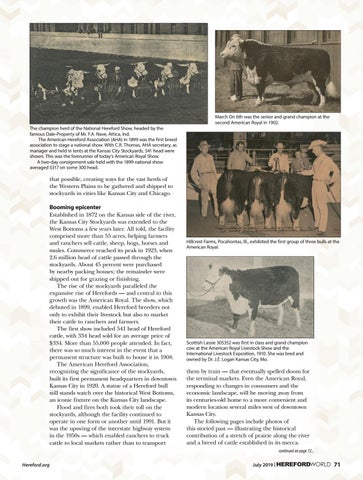The champion herd of the National Hereford Show, headed by the famous Dale-Property of Mr. F.A. Nave, Attica, Ind. The American Hereford Association (AHA) in 1899 was the first breed association to stage a national show. With C.R. Thomas, AHA secretary, as manager and held in tents at the Kansas City Stockyards, 541 head were shown. This was the forerunner of today’s American Royal Show. A two-day consignment sale held with the 1899 national show averaged $317 on some 300 head.
March On 6th was the senior and grand champion at the second American Royal in 1902.
that possible, creating ways for the vast herds of the Western Plains to be gathered and shipped to stockyards in cities like Kansas City and Chicago.
Booming epicenter Established in 1872 on the Kansas side of the river, the Kansas City Stockyards was extended to the West Bottoms a few years later. All told, the facility comprised more than 55 acres, helping farmers and ranchers sell cattle, sheep, hogs, horses and mules. Commerce reached its peak in 1923, when 2.6 million head of cattle passed through the stockyards. About 45 percent were purchased by nearby packing houses; the remainder were shipped out for grazing or finishing. The rise of the stockyards paralleled the expansive rise of Herefords — and central to this growth was the American Royal. The show, which debuted in 1899, enabled Hereford breeders not only to exhibit their livestock but also to market their cattle to ranchers and farmers. The first show included 541 head of Hereford cattle, with 334 head sold for an average price of $334. More than 55,000 people attended. In fact, there was so much interest in the event that a permanent structure was built to house it in 1908. The American Hereford Association, recognizing the significance of the stockyards, built its first permanent headquarters in downtown Kansas City in 1920. A statue of a Hereford bull still stands watch over the historical West Bottoms, an iconic fixture on the Kansas City landscape. Flood and fires both took their toll on the stockyards, although the facility continued to operate in one form or another until 1991. But it was the upswing of the interstate highway system in the 1950s — which enabled ranchers to truck cattle to local markets rather than to transport
Hillcrest Farms, Pocahontas, Ill., exhibited the first group of three bulls at the American Royal.
Scottish Lassie 305352 was first in class and grand champion cow at the American Royal Livestock Show and the International Livestock Exposition, 1910. She was bred and owned by Dr. J.E. Logan Kansas City, Mo.
them by train — that eventually spelled doom for the terminal markets. Even the American Royal, responding to changes in consumers and the economic landscape, will be moving away from its centuries-old home to a more convenient and modern location several miles west of downtown Kansas City. The following pages include photos of this storied past — illustrating the historical contribution of a stretch of prairie along the river and a breed of cattle established in its mecca. continued on page 72...
Hereford.org
July 2019 |
71
